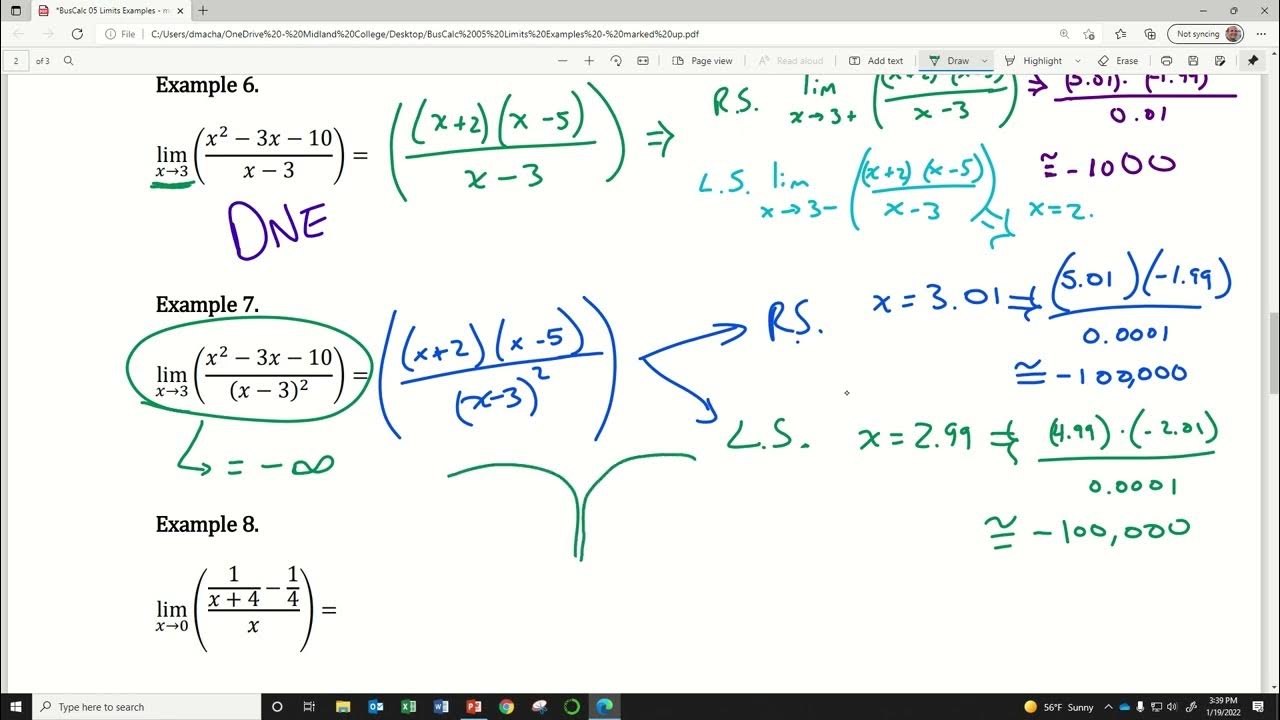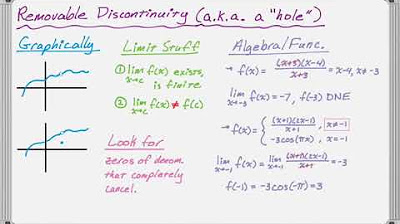Calculus 1 Review - Basic Introduction
TLDRThis video explains key calculus concepts like limits, discontinuities, and continuity. It starts with defining limits, explaining techniques like direct substitution and factoring to evaluate limits algebraically. It then covers graphical analysis of one-sided and two-sided limits, distinguishing between removable discontinuities, jump discontinuities, infinite discontinuities, and points of continuity. Examples illustrate evaluating limits analytically and graphically, identifying special points on graphs, and classifying the type of discontinuity represented.
Takeaways
- 😀 Direct substitution works to evaluate a limit if plugging in the value does not result in 0/0 or ∞/∞
- 😃 For limits that give 0/0 or ∞/∞, plug in values very close to the limit value instead
- 😉 Factor/simplify an expression first before evaluating a limit if direct substitution fails
- 🤓 Multiply top and bottom by a conjugate to evaluate limits with square roots
- 🧐 The limit exists only if the left and right hand limits match
- 😎 f(x) ≠ limit value indicates a removable discontinuity (hole)
- 🥸 Different left/right limits indicates a jump discontinuity
- 😳 Infinite left/right limits indicates a non-removable infinite discontinuity
- 🤯 All 4 values (left, right, overall limits & f(x)) match means continuity
- 🤠 Graphical analysis complements algebraic techniques for evaluating limits
Q & A
What is the concept of a limit and how is it used to evaluate functions?
-A limit looks at the value a function approaches as the input approaches some value. We can use limits to evaluate functions at values where direct substitution would result in an undefined or indeterminate result.
How can you evaluate a limit algebraically when direct substitution fails?
-You can factor or simplify the function, cancel out terms that would cause issues when substituted, and then evaluate the simplified function. Other techniques like multiplying by conjugates or common denominators can help simplify to allow direct substitution.
What is the difference between a left-handed and right-handed limit?
-A left-handed limit looks at the value approached as the input comes from smaller values, while a right-handed limit looks at values approached as the input comes from greater values. They allow investigating one-sided continuity.
When does a limit not exist?
-A limit does not exist if the left-handed and right-handed limits do not match. This represents a jump discontinuity in the function at that point.
How can you evaluate a limit graphically?
-Look at the function value approached from both sides along the vertical line representing the input value. If the values match, the limit exists and matches. If they differ, the limit does not exist.
What types of discontinuities can functions have?
-The main types are removable discontinuities (holes), jump discontinuities, infinite discontinuities (vertical asymptotes), and discontinuities where the function is undefined.
What does it mean for a function to be continuous?
-A function is continuous at a point if the left-hand limit, right-hand limit, two-sided limit, and function value all match at that input value.
What is a hole or removable discontinuity?
-This is when a function has a limit at a certain input but the function value there does not match. Plotting it results in a hollow point rather than solid.
What causes infinite or vertical asymptote discontinuities?
-These are caused by divisions by zero or other undefined operations in a function, causing the value to grow towards positive or negative infinity near some input.
How can you use limits to evaluate complex fractions or fractions with square roots?
-You can multiply top and bottom by a common denominator or conjugate to cancel out problematic terms before substituting the limit value.
Outlines
📉 Evaluating Limits Analytically and Graphically
This paragraph introduces the concept of limits, explaining what they represent and how to evaluate them analytically using direct substitution and algebraic techniques. It also covers how to evaluate limits graphically to understand one-sided limits and determine continuity.
🚀 Practice Problems for Evaluating Limits
This paragraph provides practice problems for evaluating limits both analytically and graphically, walking through examples factoring, using complex fractions, and applying conjugate multiplication.
📈 Using Values Close to the Limit to Check Answers
This paragraph demonstrates the technique of plugging in values progressively closer to the limit point to verify and check analytical solutions for limits.
❗ Understanding Continuity and Types of Discontinuities
This paragraph explains the connection between limits and continuity, distinguishing between removable, jump, and infinite discontinuities.
📉 More Practice with Graphical Limits and Continuity
This paragraph provides more graphical limit practice, analyzing one-sided limits to determine continuity and identify types of discontinuities.
✅ Identifying Continuity at a Point
This paragraph explains that continuity at a point occurs when the left-hand limit, right-hand limit, two-sided limit, and function value all match.
Mindmap
Keywords
💡limit
💡direct substitution
💡continuity
💡removable discontinuity
💡infinite discontinuity
💡jump discontinuity
💡conjugate
💡one-sided limit
💡non-removable discontinuity
💡hole
Highlights
A limit asks what value a function approaches as the input gets arbitrarily close to some number
Direct substitution works to evaluate a limit if plugging in the target input value does not make the function undefined
Factoring or simplifying the function algebraically can allow direct substitution when it otherwise would not work
Graphically finding one-sided limits involves following the curve as x values approach the target from left or right
If left and right one-sided limits differ, the two-sided limit does not exist
When a two-sided limit exists but differs from f(x) at that point, there is a removable discontinuity
When one-sided limits differ, creating a jump, there is a non-removable discontinuity
Infinite one-sided limits signal a non-removable infinite discontinuity
Matching one-sided limits and f(x) value means the function is continuous at that point
For rational function limits, multiply numerator and denominator by a conjugate expression
Square root functions can be simplified via multiplication by the conjugate
Can check an analytic limit evaluation by graphing values close to the target x
Vertical asymptotes typically signal a function value undefined at that x
Graphical context helps interpret and visualize the meaning of limits
Understanding different types of discontinuities builds intuition for limits
Transcripts
Browse More Related Video

Types of discontinuities | Limits and continuity | AP Calculus AB | Khan Academy

BusCalc 05 Limits Examples Pt 2

Calculus AB Homework 1.2 Understanding the Limit

AP Calculus AB and BC Unit 1 Review [Limits and Continuity]

AP Calculus AB Unit 1 Review | Limits and Continuity

Three Types of Discontinuities in Functions
5.0 / 5 (0 votes)
Thanks for rating: